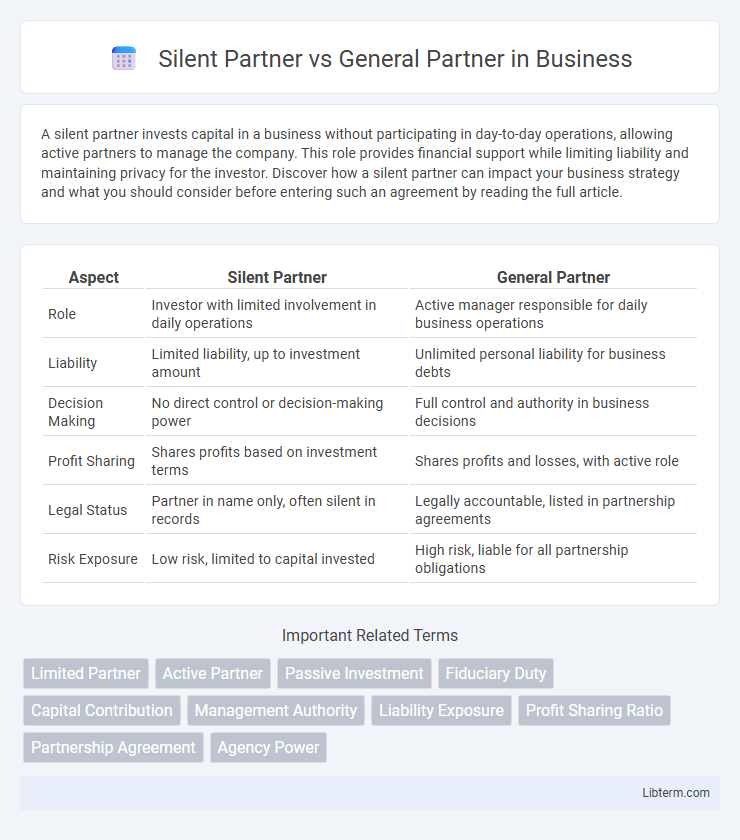A silent partner invests capital in a business without participating in day-to-day operations, allowing active partners to manage the company. This role provides financial support while limiting liability and maintaining privacy for the investor. Discover how a silent partner can impact your business strategy and what you should consider before entering such an agreement by reading the full article.
Table of Comparison
| Aspect | Silent Partner | General Partner |
|---|---|---|
| Role | Investor with limited involvement in daily operations | Active manager responsible for daily business operations |
| Liability | Limited liability, up to investment amount | Unlimited personal liability for business debts |
| Decision Making | No direct control or decision-making power | Full control and authority in business decisions |
| Profit Sharing | Shares profits based on investment terms | Shares profits and losses, with active role |
| Legal Status | Partner in name only, often silent in records | Legally accountable, listed in partnership agreements |
| Risk Exposure | Low risk, limited to capital invested | High risk, liable for all partnership obligations |
Understanding Silent Partners: Definition and Role
Silent partners invest capital in a business without participating in daily management, limiting their liability to their investment amount. This contrasts with general partners who actively manage operations and have unlimited personal liability. Understanding the silent partner's role is crucial for structuring partnerships that balance financial backing with operational control.
Who Is a General Partner? Key Responsibilities
A General Partner is an owner in a partnership who actively manages the business and assumes unlimited liability for its debts and obligations. Key responsibilities include making decisions on daily operations, representing the partnership legally, and sharing profits and losses with other partners. Unlike a Silent Partner, a General Partner engages directly in business affairs and bears full personal financial risk.
Legal Liabilities: Silent Partner vs General Partner
General partners bear unlimited legal liabilities, meaning they are personally responsible for all business debts and obligations, putting their personal assets at risk. Silent partners have limited liability, as their financial risk is confined to their investment in the partnership and they are not held accountable for daily management decisions or business debts. The distinction in legal liabilities significantly affects the level of risk each partner assumes in a business partnership.
Investment and Profit Sharing: What’s the Difference?
Silent partners contribute capital to a business without participating in daily management, receiving profit shares proportional to their investment while limiting liability. General partners actively manage the company, share unlimited liability, and usually receive a larger portion of profits due to their operational role. Investment in silent partnerships often attracts passive investors seeking profit without risk exposure, whereas general partnerships engage individuals balancing both active management and profit sharing.
Decision-Making Authority: Comparing the Two Roles
A general partner holds full decision-making authority, actively managing the business and bearing unlimited liability, whereas a silent partner contributes capital but remains passive in daily operations and decisions, limiting their liability to their investment. The general partner's control includes strategic direction, hiring, and financial commitments, contrasting with the silent partner's lack of voting rights and operational involvement. Understanding these distinctions clarifies each partner's role, risks, and influence within the partnership structure.
Risk Exposure: Which Partner Bears More?
General partners bear significantly more risk exposure than silent partners because they have unlimited liability for the debts and obligations of the business. Silent partners, also known as limited partners, face limited liability, meaning their financial risk is confined to their initial investment amount. This fundamental difference in liability directly affects decision-making authority and personal asset protection within the partnership structure.
Tax Implications for Silent and General Partners
Silent partners in a partnership are typically limited partners who do not participate in day-to-day management but still share in profits and losses, and their income is usually subject to passive income tax rules, often reducing self-employment tax liabilities. General partners actively manage the business and are subject to self-employment taxes on their share of the partnership's income, which includes Social Security and Medicare taxes. Tax implications for silent partners often involve passive income treatment, while general partners face higher tax obligations due to their active role and self-employment tax responsibility.
Advantages of Being a Silent Partner
A Silent Partner enjoys limited liability, protecting personal assets from business debts and legal actions, unlike a General Partner who faces unlimited liability. Silent Partners can invest capital and share profits without being involved in daily management, providing passive income opportunities with reduced risk and responsibility. This arrangement allows Silent Partners to diversify investments while benefiting from the business's success without operational burdens.
Pros and Cons of General Partnership Roles
General partners in a partnership hold full management authority and bear unlimited liability for business debts, which can risk personal assets but allows for active decision-making and control. The pros of this role include direct influence over daily operations and profit-sharing without intermediaries, fostering strong collaboration and swift responsiveness. However, cons involve exposure to personal financial risk, potential conflicts with other partners, and a significant commitment of time and resources to manage the business effectively.
Choosing the Right Partnership Model for Your Business
Choosing the right partnership model involves understanding that a Silent Partner invests capital without participating in daily management, limiting their liability to their investment, while a General Partner actively manages the business and bears unlimited liability. Businesses seeking passive investors with reduced personal risk often opt for Silent Partners, whereas those needing hands-on management prefer General Partners. Carefully assessing your business goals, risk tolerance, and management preferences ensures selecting the partnership structure that aligns with your operational and financial needs.
Silent Partner Infographic

 libterm.com
libterm.com